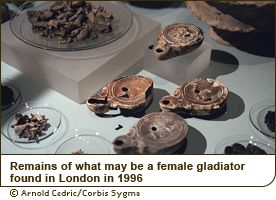

Illustrious Fame used to sing of the lion laid low in Nemea’s spacious vale, Hercules’ work. Let ancient testimony be silent, for after your shows, Caesar, we have now seen such things done by women’s valor.
—Martial, On the Spectacles
With terrific fanfare, the emperor Titus Flavius Vespanianus opened the great Colosseum of Rome in 80 CE. The inaugural games reportedly ran one hundred days, wowing crowds with exotic animal hunts and gladiatorial contests by the thousands. The poet Martial devoted an entire book to these extravagant festivities, but despite his allusions to the deeds of gods and fabled heroes, those who performed for the emperor’s pleasure were all too mortal: flesh-and-blood men—and women—who fought and died in this distinctly Roman form of entertainment.
Little is known about the women who joined in the violent spectacle, but tantalizing clues to their existence can be found throughout ancient Roman literature, history and art. Who were these women who stood against tooth, claw and sword? And why would they risk their lives in brutal sport?
Death or Glory
 Gladiators took their name from their primary weapon. Like ancient Roman legionaries, many relied upon the gladius, a short thrusting blade ideal for close-quarters combat. Yet these were no citizen soldiers. Gladiators were often drawn from the dregs of society: slaves, criminals and foreign prisoners of war. Unlike others of their ilk, who faced outright execution or toiled in harsh servitude to an early grave, gladiators knew the faint glimmer of hope: A very skilled—and very lucky—fighter might redeem herself or himself in battle, winning fame, fortune and ultimately freedom.
Gladiators took their name from their primary weapon. Like ancient Roman legionaries, many relied upon the gladius, a short thrusting blade ideal for close-quarters combat. Yet these were no citizen soldiers. Gladiators were often drawn from the dregs of society: slaves, criminals and foreign prisoners of war. Unlike others of their ilk, who faced outright execution or toiled in harsh servitude to an early grave, gladiators knew the faint glimmer of hope: A very skilled—and very lucky—fighter might redeem herself or himself in battle, winning fame, fortune and ultimately freedom.
Death was not always assured in gladiatorial combat. A relief from Halicarnassus records a remarkable event in which two female gladiators fought to a draw, but their skill and fortitude so impressed the crowd that both were spared. The women are identified as Amazon and Achillia. These were probably stage names chosen to evoke images of those legendary women warriors who locked in combat with Achilles, the Greek hero who killed the Amazon queen Penthesilea. While their names may have been mythic, their peril was all too real. Both are depicted with sword and shield in hand, poised to strike. Had they not received their celebrated reprieve, at least one of these women would not have walked out of the ring alive.
Stakes were high, but contests followed a clear structure, supervised by referees and governed by strict rules and rituals. Gladiators were organized into standardized types, each with unique arms, equipment and fighting moves.
Amazon’s and Achillia’s gear mark them as provocatores, a class of fighter that enjoyed a fair amount of protection from their rectangular shields, arm and lower-leg coverings and helmets (in the relief, these rest by their feet, having been cast aside to signal a stalemate). That these women fought in a recognized style suggests that their training and techniques may have paralleled those of their male counterparts.
Survival of the Fittest
Women are known to have served as specialty performers in the amphitheater as well. An essedaria—a female gladiator who fought from a British-style war chariot—is mentioned in Petronius’ Satyricon. Historical documents also record women venatores, expert hunters who were not considered gladiators but still appeared in the arena. Like gladiators, these highly specialized hunters trained in schools, but they honed their skills against animal opponents. The “bullfighters” of their time, they battled all manner of beast, including lions, tigers and bears.
Successful gladiators could attain almost superstar status. Not unlike modern prizefighters or champion racehorses, they spent most of their time in training and made only a handful of heavily promoted appearances a year. They ate a special diet and were kept in top condition by doctors and masseurs. Veteran gladiators who put on a good show and knew how to please their audience were so sought after that emperors were known to offer them vast sums to come out of retirement.
For the Love of the Sword
Both admired and reviled, gladiators represented a powerful social contradiction, but none more so than sword-wielding women. Proper Roman women, especially those in high society, were expected to be demure and virtuous.
Gladiators embodied danger and excitement, so it’s little wonder that many Romans citizens were attracted to the arena, some even willing to put aside their freedom to test their mettle. Several emperors allegedly trained in gladiatorial techniques, as did other members of the upper classes, women included.
The Roman satirist Juvenal mocked the adventure-seeking ladies who spent hours practicing their swordwork. Ancient writers’ derisive remarks might give the impression that women’s combat was the exclusive domain of bored Roman matrons out for a cheap thrill. But it was precisely because they defied the conventions of their rank and gender that they so outraged their male peers.
So many respectable women dabbled in the life of the amphitheater that lawmakers apparently felt compelled to act. In the early first century, the Roman Senate passed two decrees barring freeborn men and women of marriageable age from appearing on stage or in the arena. Yet by the middle of the century, the historian Cornelius Tacitus, who also recorded the history of Boudica, reported that the number of “distinguished women” who degraded themselves in this way exceeded “all precedent.” Nor does the tide seem to have been stemmed by the end of the second century, when Emperor Lucius Septimius Severus, who ruled from 193 to 211 CE, banned all women from fighting, regardless of age or station.
Much about these women’s lives remains a mystery. We might find it hard to understand why anyone would engage in mortal combat for the amusement of the masses. For some, however, it may have seemed the only way to transcend the restrictions society placed on their sex and status. But a discovery in Britain has shown that even this career choice had its limitations.
 In 2000, archaeologists from the Museum of London unearthed a riddle: an unmarked, but richly appointed, grave of a woman set at the unfashionable outer edge of a Roman cemetery. The museum concluded that the objects found with her cremated remains suggested that she had been a successful gladiatrix. But despite all her trappings of wealth and privilege, she remained an outcast even in death. Perhaps future discoveries will reveal more about these remarkable women warriors.
In 2000, archaeologists from the Museum of London unearthed a riddle: an unmarked, but richly appointed, grave of a woman set at the unfashionable outer edge of a Roman cemetery. The museum concluded that the objects found with her cremated remains suggested that she had been a successful gladiatrix. But despite all her trappings of wealth and privilege, she remained an outcast even in death. Perhaps future discoveries will reveal more about these remarkable women warriors.
:: Amy Zoll
Gladiators Selected Sources







